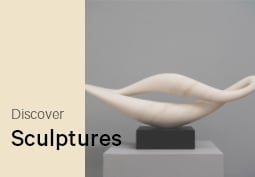Art Movement: Surrealism
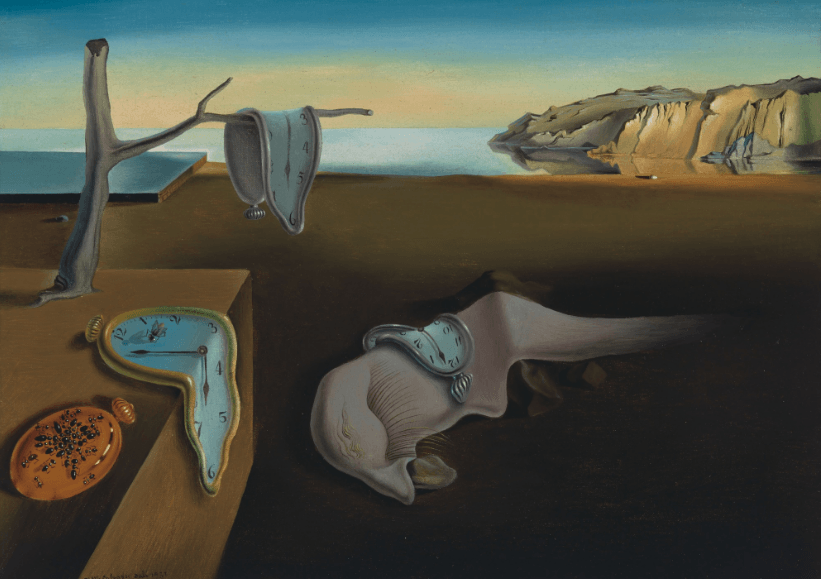
“Surrealism is based on the belief in the omnipotence of dreams, in the undirected play of thought.” – André Breton
Surrealism definition: what is Surrealism?
Dalí’s melting clock, Magritte’s figures composed from clouds, Frida Kahlo’s self-portrait as a hunted stag… These are just a few of the familiar images that come to mind when we speak of Surrealism. The art movement, which blossomed in the 1920s with André Breton at the helm, rejected the society’s oppressive rationality. Instead, the movement’s followers explored the irrational and the subconscious mind, which they deemed superior to oppressive rationality. Breton was also influenced by the psychoanalytical writings of Sigmund Freud, who posited that the unconscious mind (which expressed itself, for example, through dreams) was the source of creativity. Surrealist artists deployed automatic drawing or writing to unlock ideas from their subconscious, often depicting elements from their dreamscapes.
Key dates: 1924 – 1966
Key regions: Paris, New York
Key words: surrealist, subconscious, irrational, automatism, dreams
Key artists: André Breton, Salvador Dalí, André Masson, Rene Magritte, Joan Miró, Yves Tanguy, Max Ernst, Frida Kahlo, Diego Rivera, Meret Oppenheim, Jean Arp, Man Ray, Wifredo Lam


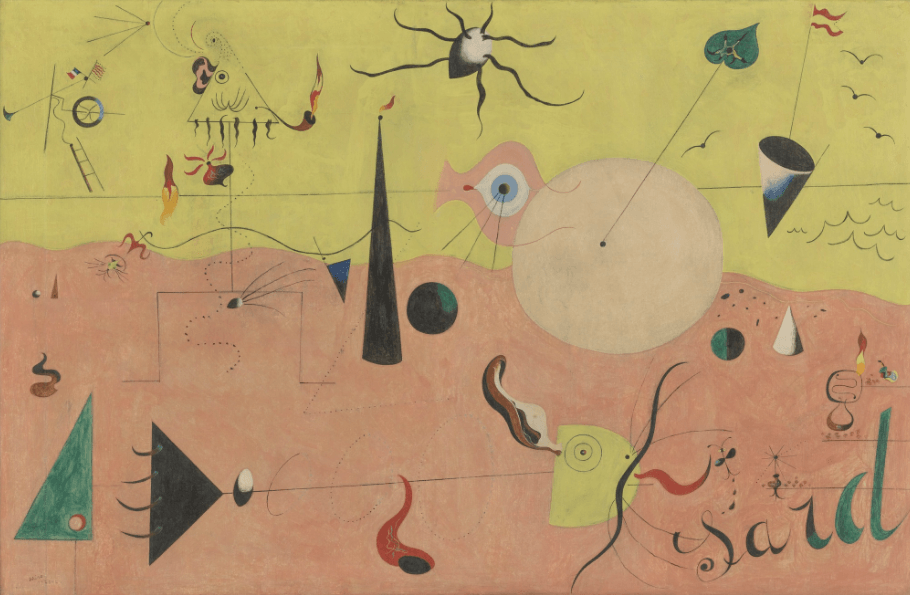
“Surrealism: Psychic automatism in its pure state, by which one proposes to express, either verbally, in writing, or by any other manner, the real functioning of thought, in the absence of any control exercised by reason, exempt from any aesthetic or moral concern.” – André Breton, Surrealist Manifesto
Origins of Surrealism
When early forms of Surrealism originated in the late 1910s, it was essentially a literary movement. In 1915, the young André Breton was already well versed in literature, contemporary art, anarchism and medicine. The First World War was raging in Europe and he was assigned as a nurse in a Nantes military hospital. The horrors of the war made a deep impression on Breton and he wrote his first poems there. He also met two men who were to become his mentors – Guillaume Apollinaire and Jacques Vache. Both had been admitted to the hospital due to war wounds. Apollinaire was a French avant-garde poet who had coined the word “surrealist” in his play, which was performed in 1917. However, it was André Breton who really defined surrealism as an artistic movement in his 1924 Surrealist Manifesto. To him, Surrealism was “psychic automatism in its pure state, by which one proposes to express, either verbally, in writing, or by any other manner, the real functioning of thought, in the absence of any control exercised by reason, exempt from any aesthetic or moral concern.”
Based on his renewed convictions, Breton opened a designated gallery in Paris, the Galerie Surréaliste, and also decided to set up a series of collective exhibitions starting with the first one at Pierre Loeb’s gallery in 1925. It featured pieces by both Surrealist members and other, somewhat related, artists such as Paul Klee, Pablo Picasso, Man Ray, and Marcel Duchamp, considered to be kindred to surrealist artistic aspirations because of the imaginative and provocative qualities of their work. Other shows followed as Surrealism’s fame and influence grew internationally.
Key ideas behind Surrealism
Although early Surrealist poets were hesitant about engaging in art production as, in their view, the mechanical act of creating art – whether it was drawing, painting, or sculpting – impeded the spontaneous expression of the unconscious, around the mid-1920s the prime theorist of Surrealism André Breton, in his seminal Surrealism and Painting, reconsidered the potential of visual arts as a means to unlock the power of the psyche and create absurd imagery, partly humorous and partly ominous: a manifestation of contradictions in everyday life. Few other artistic movements were as cross-sectorial and inclusive as Surrealism. Not defined by any specific medium or style, it spanned all those disciplines capable of manifesting the uncanny side of reality, ranging from Visual Arts to Music, Theatre, and Cinema. It entailed a philosophical approach instead, as – in artist Joyce Mansour’s words – “It is not the technique of painting that is surrealist, it’s the painter and the painter’s vision of life”.
Famous Surrealist Artworks
Salvador Dalí’s The Persistence of Memory (1931)
Arguably Dalí’s most famous artwork, The Persistence of Memory portrays clocks, otherwise hard objects, becoming inexplicably limp and bendable. Here, time literally bends, and the creature draped across the centre of the canvas seems to be simultaneously melting, sleeping and dying. Dalí’s “hand-painted dream photographs” present his absurd visions and dreams in an unbelievably tangible and realistic manner.
Rene Magritte’s The Treachery of Images (1928)
Magritte’s realistic painting of a simple wooden pipe has become one of the most iconic paintings of the Surrealist movement. Beneath the pipe is the inscription “Ceci n’est pas un pipe” (‘This is not a pipe’). Magritte was inspired by metaphysical philosophy, offering the viewer a paradox. What can be seen is a pipe, but his words contradict this immediate understanding of the painting. If it is not a pipe, then what is it? Magritte inspires the viewer to think about the relationship between language and everyday objects, as well as art versus reality.
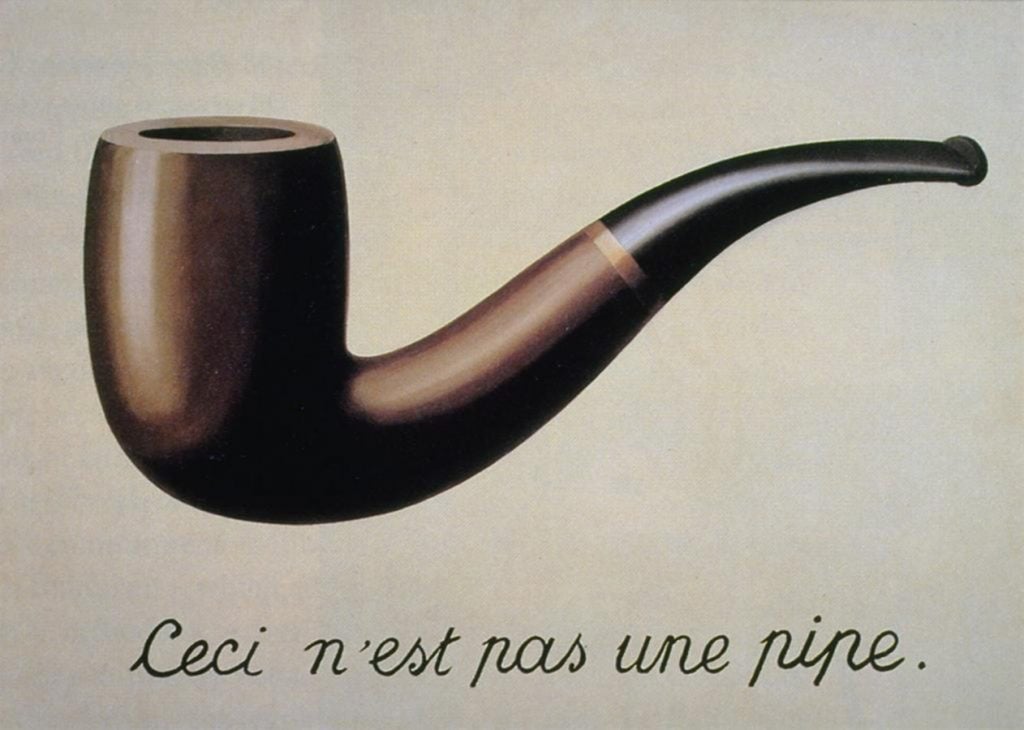
Joan Miró’s The Hunter (Catalan Landscape) (1924)
Miró’s The Hunter depicts a surrealist landscape inspired by Catalonia, where his family was from. The landscape is saturated with strange triangular shapes, orbs, and disembodied human and animal forms. In fact, the only truly recognisable organisms in the painting are the birds. The forms and figures hover, float, and seem to be in constant motion. In the foreground, the word “sard” is written, short for “Sardana”, Catalonia’s national dance. The shortened word was inspired by the fragmented words of Dadaist and Surrealist poetry.
Frida Kahlo’s The Wounded Deer (1946)
This iconic painting depicts Frida Kahlo as a wounded deer, punctured by multiple arrows. She painted the painting after an unsuccessful spinal surgery in New York in 1946. By presenting this self-portrait of herself as a hunted half-stag, half-human, she shares her suffering with the viewer. Her choice to represent herself as a stag, a male deer, might refer to her bisexuality.
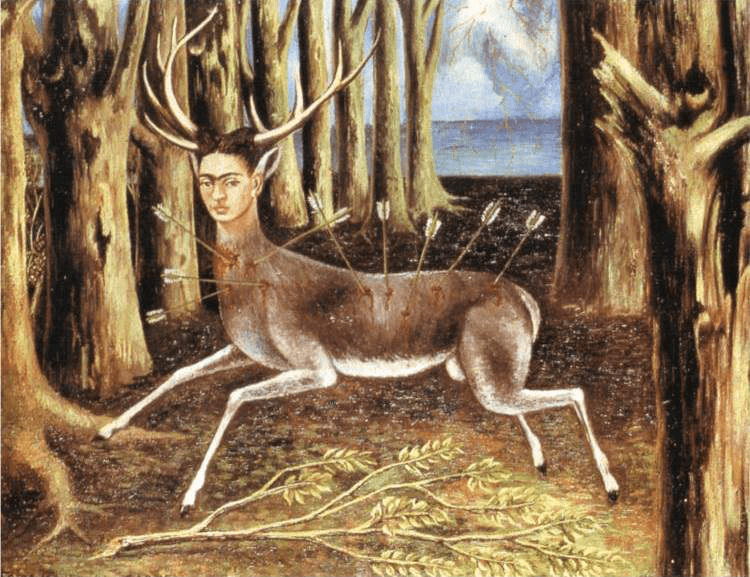
Meret Oppenheim’s Object (1936)
Meret Oppenheim’s Object, a fur-covered cup and saucer, was inspired by a conversation with Pablo Picasso and Dora Maar. Picasso was admiring Oppenheim’s fur-covered bracelet and remarked that one could cover anything with fur. Oppenheim then replied: “Even this cup and saucer.” When André Breton asked her to participate in the first Surrealist exhibition of objects, she bought a cup, saucer and spoon and covered them in the fur of a Chinese gazelle. Thus, Oppenheim transformed the delicate, dainty objects into something sensual and sexual.
Man Ray’s l’Heure de l’Observatoire: les Amoureux (1932-1934)
Man Ray’s famous painting depicts the sensual red lips of Lee Miller, his former lover and protégé. Ray painted it after their relationship ended in 1932. The giant lips float in the sky and also represent the two bodies of Man Ray and Lee Miller.
Surrealism in Europe and America
Surrealism was born in Paris, France, and this remained the main hub for the movement throughout the ‘20s and ‘30s. The main artists associated with the movement in Europe were André Breton, Salvador Dalí, André Masson, Rene Magritte, Joan Miró, Yves Tanguy, Max Ernst, Meret Oppenheim, Jean Arp, Man Ray and Wifredo Lam. Initially, André Breton formed a connection to the Dada movement through correspondence with Tristan Tzara. However, the two severed ties due to various differences and Breton then founded Surrealism in 1924 with his Surrealist Manifesto. During World War II, many Surrealist artists (including André Breton and Max Ernst) fled Europe. Many ended up in the United States, where they influenced a whole host of American artists. The chance elements central to surrealist art contributed to the development of a new type of art in America. In particular, the Abstract Expressionists, with their anti-war, spontaneous, unscripted art, owes a great deal to the Surrealists.
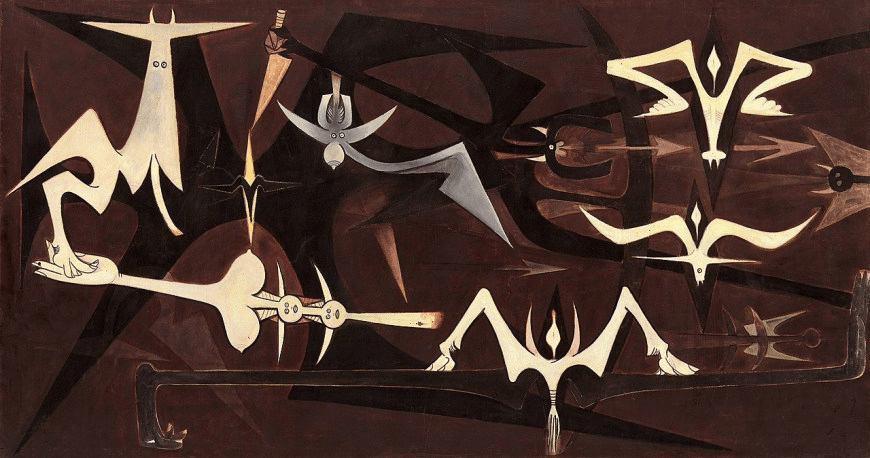
Surrealism in Central and Latin America
Although the great Mexican artists Frida Kahlo and Diego Rivera were never officially part of the Surrealist movement, they are often associated with Surrealism. Kahlo said: “They thought I was a Surrealist, but I wasn’t. I never painted dreams. I painted my own reality.” Still, André Breton visited Kahlo and Rivera in Mexico. He also organised the Fourth International Surrealist Exhibition in Mexico City, which included works by the two artists. Though not officially tied to the movement, they certainly worked with many Surrealist topics, like the subconscious, dreams, and symbolism. The Cuban-born artist Wifredo Lam (who was of mixed Afro-Chinese-Cuban descent), was another important artist in the Surrealist movement. Lam studied in Madrid and Paris, where he became close friends with Picasso and was introduced to Surrealism. Lam’s paintings reflected on social injustices and spirituality.
Surrealism in Film and Literature
Surrealism was not just limited to the visual arts. On the contrary, since Breton started out as a poet, Surrealism naturally became influential in literary circles. Important proponents of Surrealist literature were André Breton, Paul Eluard, Robert Desnos, Georges Bataille, Philip Soupalt, Louis Aragon and Antonin Artaud. In cinema, Luis Buñuel made waves with his Surrealist films like Un Chien Andalou (1929, made with Salvador Dalí). The Surrealists in cinema used new techniques and approaches to free the art of cinema from traditional storytelling. Instead, they wanted to transform the medium into one that could explore and reveal the inner workings of the subconscious.
The Influence of Surrealism
Surrealism had a profound influence on Abstract Expressionism, and on the unscripted Happenings in the 1950s promoted by Allan Kaprow. The Situationist International in the 1960s is also indebted to Surrealist ideas and methods. Surrealism is considered to have ended with the death of André Breton in 1966. However, the movement continues to inspire countless contemporary artists today. Artists like David Lynch, Julie Curtiss and Mary Reid Kelley, to name but a few, work with a great deal of Surrealist imagery and techniques.
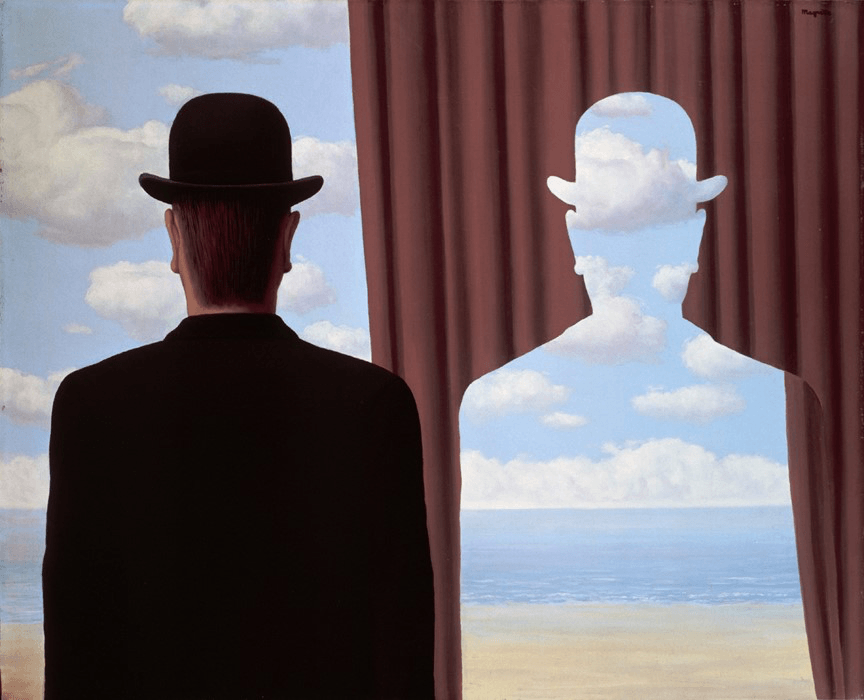
Written by Shira Wolfe
Relevant sources to learn more
Read more about Art Movements and Styles Throughout History here
The Fantastic Women Of Surrealism
Cursed Images: A Short History of The Uncanny
Female Iconoclasts: Leonora Carrington
Les Dîners de Gala: Surrealism on the menu with Salvador Dalì’s cookbook
Bill Brandt: The Beautiful and the Sinister

